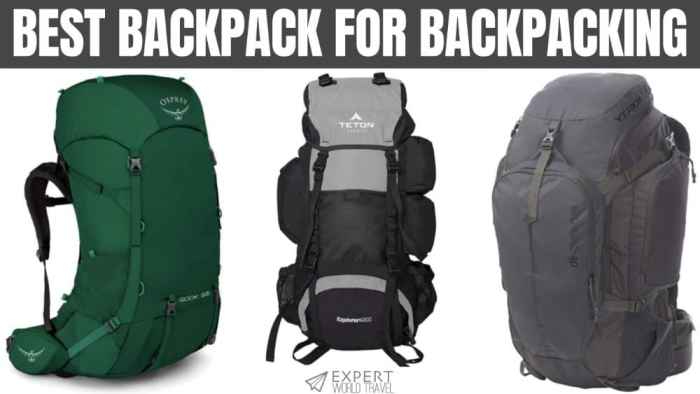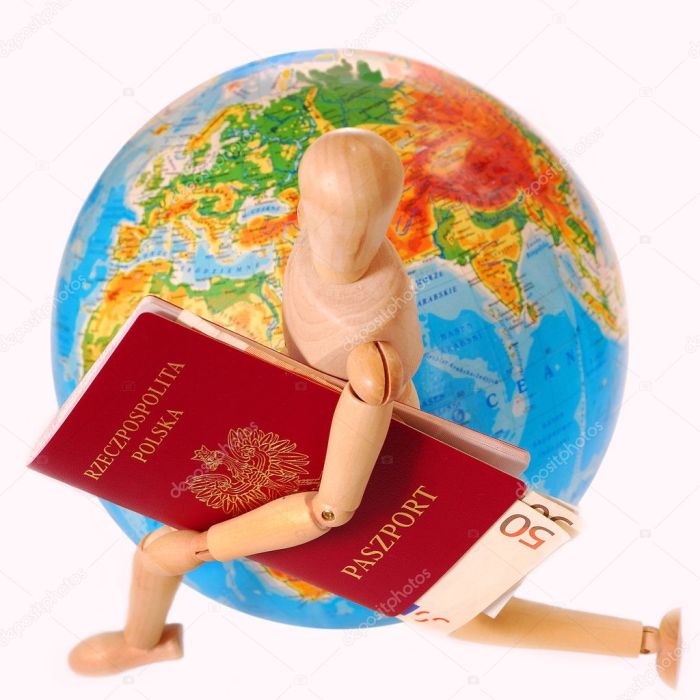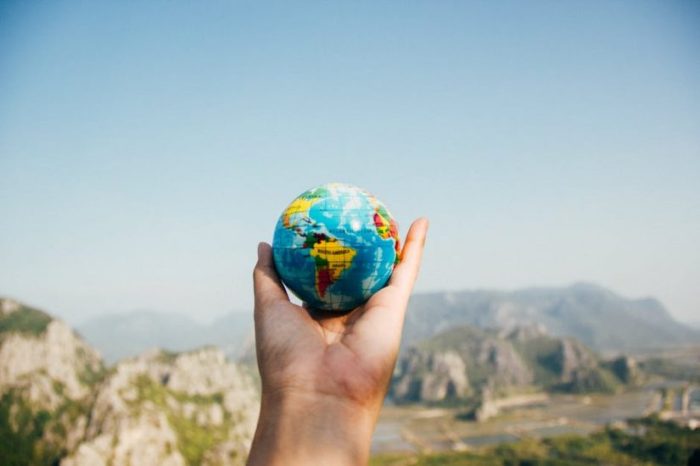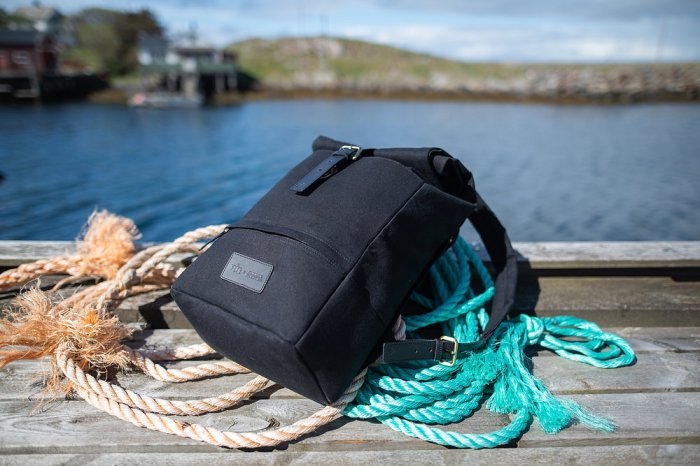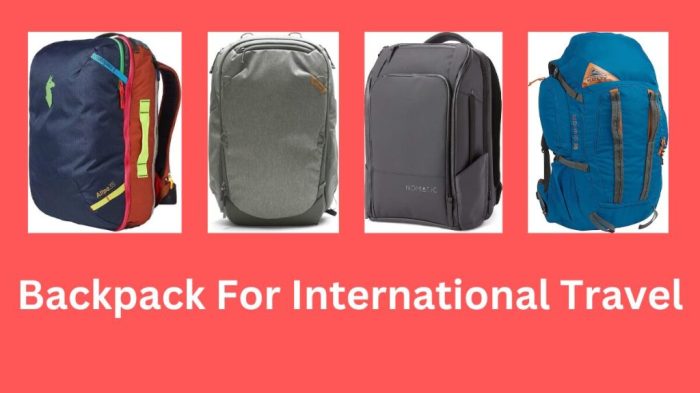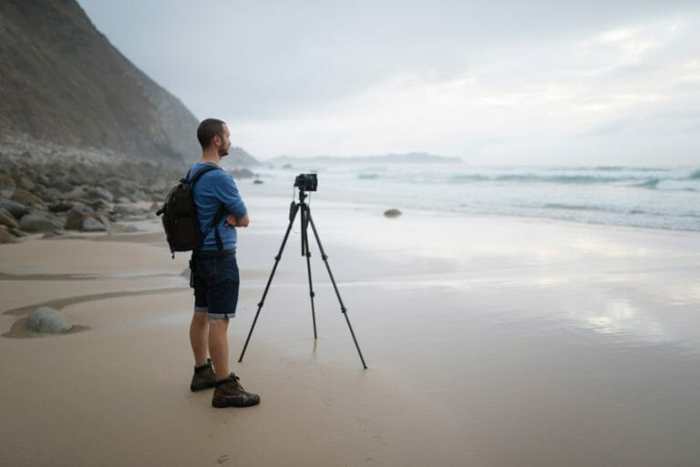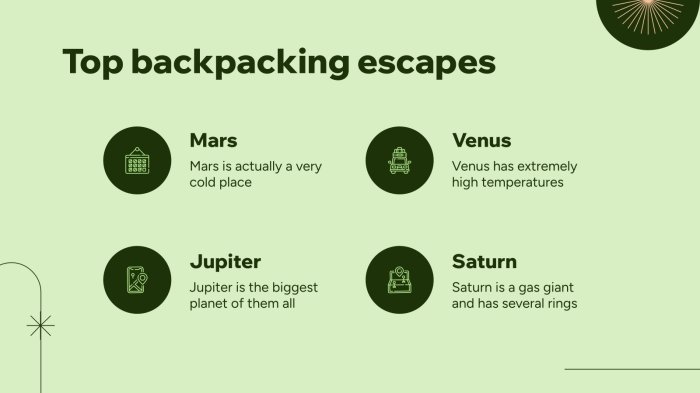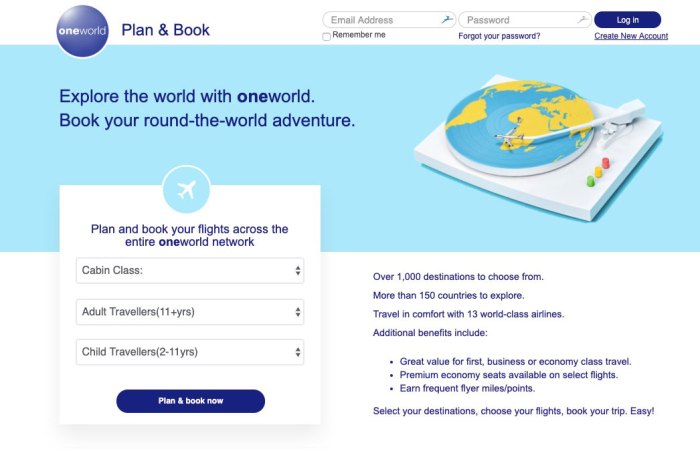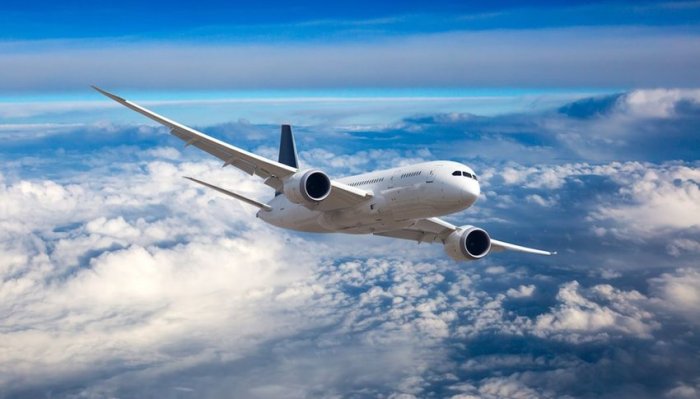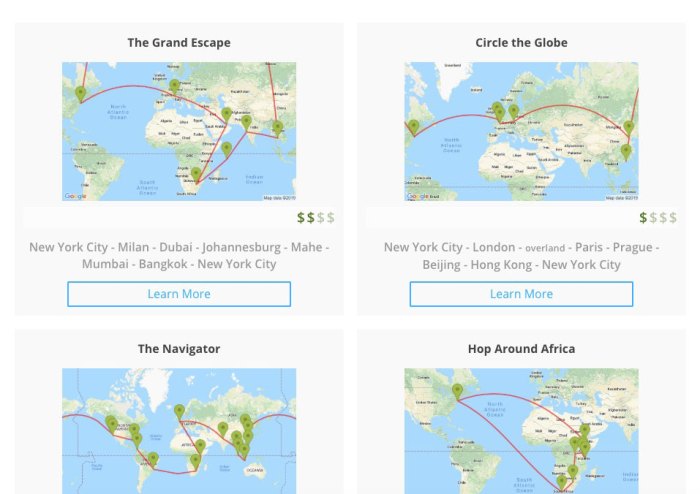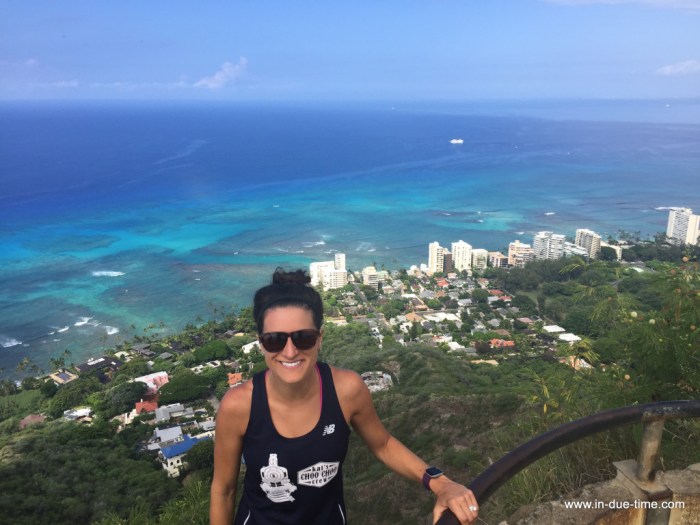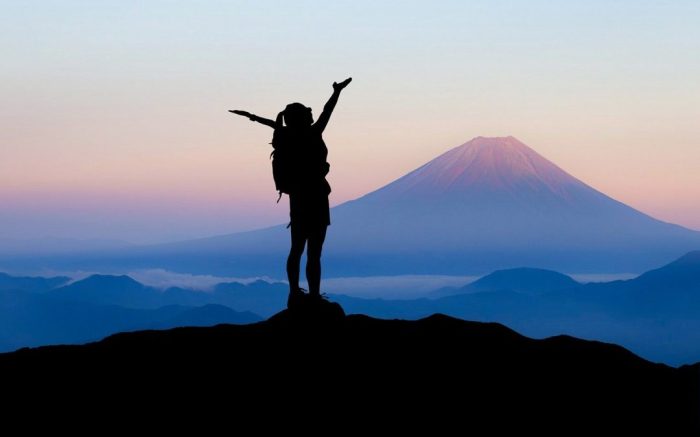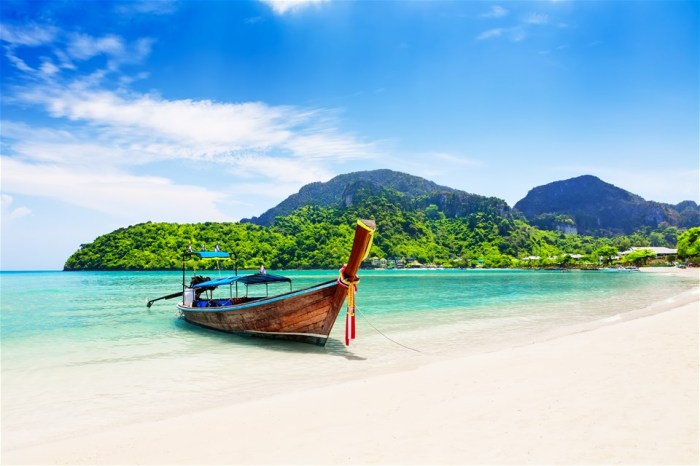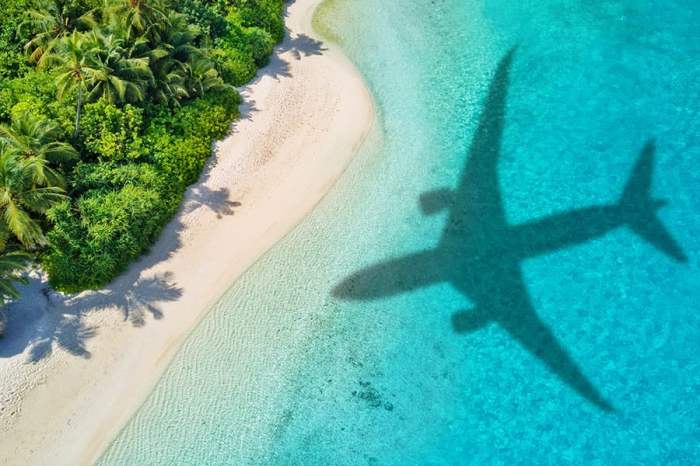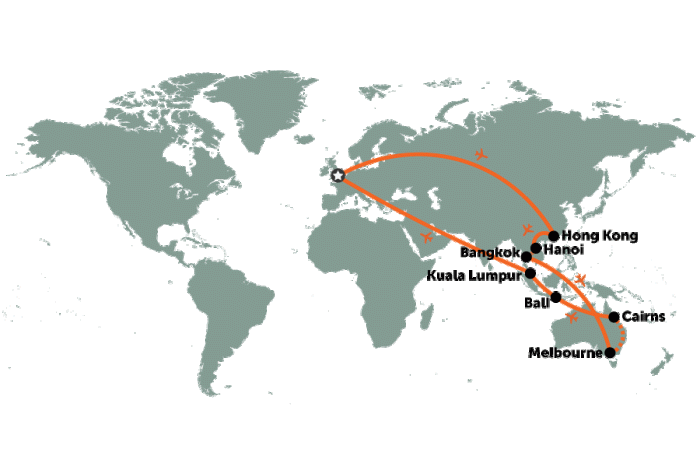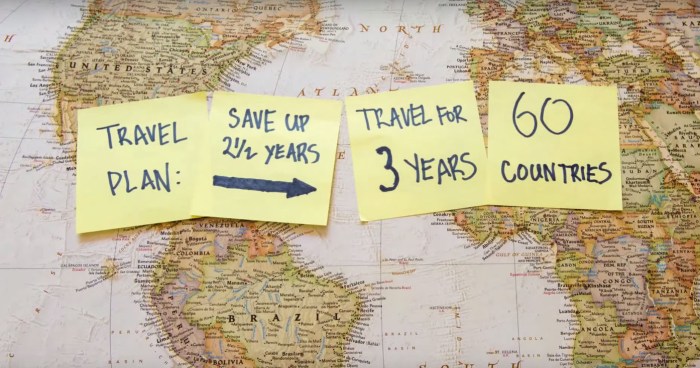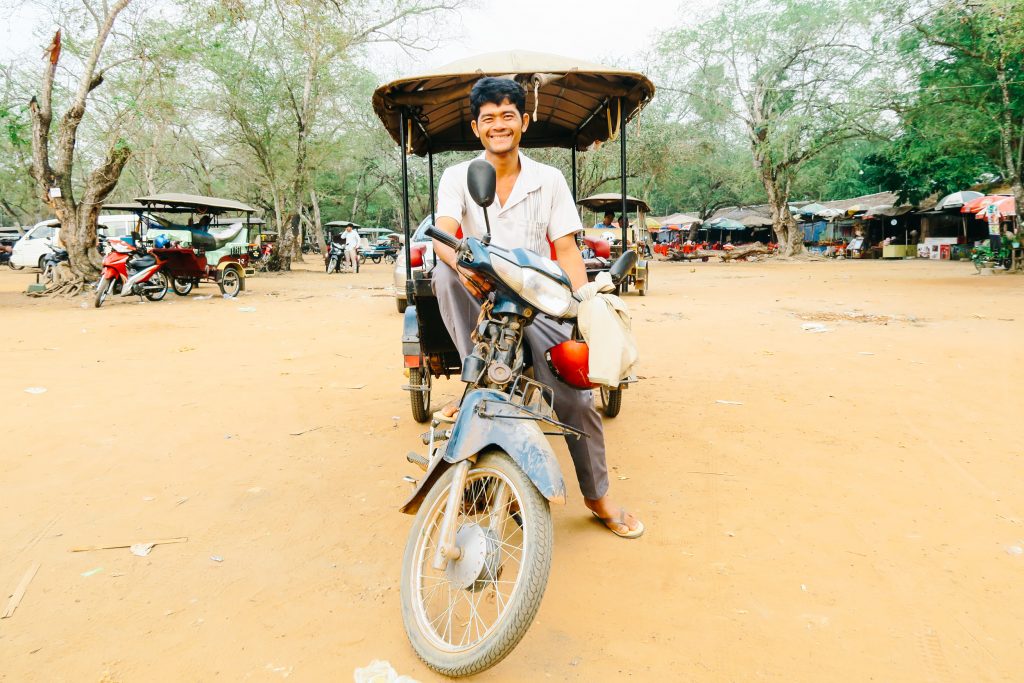Travel around the world itinerary: Embark on a transformative journey, crafting an unforgettable global adventure. This comprehensive guide will equip you with the knowledge and strategies to plan and execute your dream trip, from meticulous planning to navigating unexpected challenges.
This detailed Artikel covers everything from defining the perfect itinerary type, whether budget-friendly or luxurious, to understanding the crucial aspects of planning, organizing, and executing your dream trip. We’ll explore different organizational methods, from chronological to thematic, providing actionable insights and visual aids to help you structure your global journey effectively. Essential practical aspects, including documents, insurance, transportation, and packing, will be discussed in detail.
Sample itineraries, cost considerations, and crucial cultural sensitivity tips round out the comprehensive guide.
Defining the Itinerary
A travel around the world itinerary is a meticulously planned journey encompassing various destinations across the globe. It details the route, duration, accommodation, activities, and often, the budget allocated for the trip. A successful itinerary ensures a seamless and fulfilling experience, maximizing time and resources while minimizing stress. It’s a roadmap for exploring the world, tailored to individual preferences and travel style.This comprehensive guide differentiates between a fast-paced whirlwind tour and a more relaxed, immersive experience, highlighting the various types of itineraries available, ranging from budget-friendly to luxurious adventures.
Each approach offers distinct advantages and drawbacks, impacting the overall travel experience.
Types of Travel Itineraries
Travel itineraries encompass a spectrum of styles, catering to diverse needs and preferences. These range from budget-conscious trips to opulent journeys, adventurous explorations, and culturally immersive experiences. Understanding the nuances of each type helps travelers choose an itinerary that aligns with their aspirations and financial constraints.
Defining Key Itinerary Types
Different types of itineraries cater to various preferences and budgets.
- Budget-Friendly Itineraries: These itineraries prioritize affordability, often emphasizing budget-friendly accommodations, local transportation, and self-catering options. They typically involve maximizing free activities, like exploring local markets and museums, rather than expensive excursions.
- Luxury Itineraries: Luxury itineraries prioritize high-end accommodations, premium transportation, and exclusive experiences. These often include private tours, gourmet meals, and access to premium attractions. They frequently involve premium accommodations and private guides, tailored to create a memorable and indulgent experience.
- Adventure Itineraries: Adventure itineraries emphasize active exploration, challenging activities, and immersion in natural environments. These include trekking through mountains, kayaking through rivers, and wildlife viewing. These typically focus on outdoor activities and may include specialized gear or training for specific experiences.
- Cultural Immersion Itineraries: Cultural immersion itineraries prioritize understanding and experiencing the local culture through interactions with the community, learning about traditions, and engaging in local activities. These itineraries frequently involve staying in local homes, participating in cultural workshops, and immersing oneself in the daily lives of the locals.
Comparing Itinerary Types
The table below highlights the advantages and disadvantages of different itinerary types.
| Itinerary Type | Pros | Cons |
|---|---|---|
| Budget-Friendly | Affordable, allows for more destinations, promotes independent travel, and often fosters a deeper connection with local culture. | Limited luxury, potential for less comfort, more time commitment for research and planning, and may involve basic amenities. |
| Luxury | Exceptional comfort, personalized service, and access to exclusive experiences. Often includes high-quality accommodations and premium amenities. | Expensive, potentially less opportunity for spontaneous exploration, and can feel impersonal due to structured itineraries. |
| Adventure | Exciting and fulfilling experiences, physical challenges, and immersion in natural environments. | Potential for physical risks, demanding activities, and a need for specific skill sets and equipment. |
| Cultural Immersion | Deep understanding of local culture, personal growth, and unique perspectives. Allows for building connections with the community and learning new traditions. | Requires adaptability and an open mind, potential language barriers, and may involve unexpected challenges. |
Planning Considerations
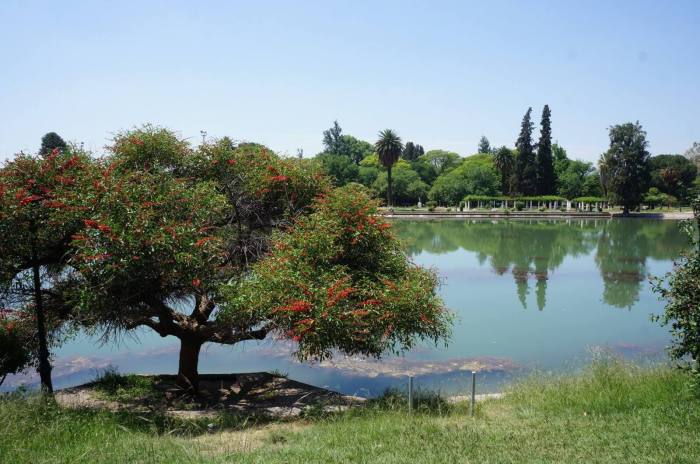
Source: novo-monde.com
Crafting a global travel itinerary requires meticulous planning, but consider exploring options like around the world trips all inclusive to streamline the process. These curated experiences often handle logistics, allowing travelers to focus on the destination’s allure and immerse themselves in each unique culture. Ultimately, a well-defined itinerary remains crucial for maximizing the rewards of any global adventure.
Global travel requires meticulous planning, encompassing a multitude of factors. A well-structured itinerary ensures a smoother journey, maximizing enjoyment and minimizing potential issues. Successful global travel involves careful consideration of resources, time, interests, and local nuances. This section delves into essential planning considerations, from budget management to cultural sensitivity.Effective global travel planning involves a holistic approach, considering the interplay of diverse elements.
Prioritizing research, budgeting, and understanding local customs allows travelers to fully immerse themselves in the destination culture while ensuring safety and enjoyment. A well-defined timeline and balanced approach to attractions and local experiences are crucial for a memorable journey.
Crafting a compelling travel around the world itinerary demands careful consideration of diverse destinations and optimal routes. To ensure a smooth and enriching experience, researching reputable travel agencies and resources like Travel is crucial. This meticulous planning will ultimately lead to a rewarding global adventure.
Budgeting for the Trip
Careful budget management is paramount for any global adventure. Determining a realistic budget based on the destinations and activities chosen is crucial. Accommodation, transportation, food, activities, and visa fees all contribute to the total cost. Expenses vary significantly between regions, requiring a granular understanding of the local cost of living.
- Accommodation: Consider a mix of hotels, hostels, or Airbnb options to suit different budgets and preferences. Compare prices across platforms and consider location factors that might affect cost.
- Food: Local markets and street food often offer affordable and authentic culinary experiences. Plan for occasional dining out, taking into account price ranges in different areas.
- Activities: Many destinations offer free activities, such as exploring parks, walking tours, or visiting local markets. Research options for affordable entertainment to maximize your budget.
Time Constraints and Realistic Timeline
Time management is critical for maximizing the experience. A detailed timeline helps structure the trip, ensuring that destinations and activities are visited efficiently. Unrealistic schedules can lead to rushed experiences and missed opportunities.
- Duration of Stay: Determine the optimal time to spend in each location, balancing exploration with sufficient downtime. Consider the pace of the destination and the traveler’s desired level of engagement.
- Transportation: Research travel times between locations. Efficient travel strategies are vital to avoid delays or missed connections. This includes factoring in travel time between airports, train stations, or other transportation hubs.
- Travel Flexibility: Build in buffer time for unexpected delays or changes in plans. A flexible approach allows for adaptability and the ability to seize unforeseen opportunities.
Visa Requirements and Travel Documents, Travel around the world itinerary
Visa requirements vary considerably across countries. Thorough research and preparation are essential to avoid travel delays or difficulties. Knowing the specific visa requirements for each country visited and securing the necessary documentation in advance is critical.
- Passport Validity: Ensure your passport is valid for the duration of your trip and beyond. Consult with embassies and consulates for the latest requirements.
- Visa Application: Start the visa application process well in advance, as processing times can vary significantly.
- Documentation Checklist: Create a comprehensive checklist of all required documents, including copies of passports, visas, and travel insurance.
Researching Destinations and Local Customs
Thorough research into local customs, traditions, and etiquette is essential for respectful travel. Understanding the local culture and customs fosters positive interactions and enhances the overall experience. Learning basic phrases in the local language adds a personal touch.
- Cultural Sensitivity: Research the local culture, customs, and traditions to avoid cultural faux pas. Respecting local customs is essential for a positive experience.
- Local Etiquette: Research local customs regarding greetings, dining, and other social interactions. This includes understanding dress codes and social norms.
- Language Learning: Learning basic phrases in the local language demonstrates respect and enhances communication. This can include phrases for greetings, ordering food, and asking for directions.
Balancing Attractions and Local Experiences
A well-balanced itinerary includes both iconic attractions and opportunities to engage with local culture. Prioritizing local experiences, such as visiting markets, interacting with locals, and sampling local cuisine, enriches the travel experience.
- Local Experiences: Prioritize opportunities to interact with locals, participate in cultural events, and explore local markets and communities.
- Must-See Attractions: Plan visits to iconic landmarks and attractions that align with personal interests.
- Finding a Balance: Strategically incorporate local experiences and must-see attractions to create a well-rounded and memorable itinerary.
Itinerary Structure and Organization
Crafting a comprehensive travel itinerary is more than just a list of destinations. It’s a strategic roadmap that reflects personal preferences and anticipates potential challenges. Effective organization is key to maximizing enjoyment and minimizing stress during your global adventure. A well-structured itinerary ensures seamless transitions, allows for flexibility, and caters to the specific needs and interests of the traveler.Careful planning, especially for extensive journeys, transforms a potentially overwhelming experience into a well-managed and rewarding voyage.
Prioritizing destinations, balancing activities, and anticipating potential issues are crucial steps in ensuring a successful trip. This section delves into the methods of organizing itineraries, highlighting their strengths and weaknesses, and demonstrating how to prioritize destinations and activities based on individual preferences.
Itinerary Organization Methods
Different approaches to organizing a global itinerary cater to diverse travel styles. Understanding the various methods allows travelers to select the approach best suited to their needs and preferences. A chronological approach, for example, might be ideal for those seeking a structured, linear experience, while a thematic approach might suit those interested in immersing themselves in a specific culture or activity.
| Organization Method | Description | Pros | Cons |
|---|---|---|---|
| Chronological | Arranging destinations and activities sequentially, typically following a time-based schedule. | Easy to follow, provides a clear timeline, useful for structured travelers. | May not cater to specific interests, can be inflexible, less room for spontaneity. |
| Thematic | Grouping destinations and activities based on a shared theme or interest, like history, food, or nature. | Allows for in-depth exploration of specific interests, enables focused experiences. | May require more research to ensure coherence, can feel disjointed if not carefully planned. |
| Region-by-Region | Organizing travel based on geographical regions, offering a holistic view of a specific area. | Provides a comprehensive understanding of a region’s culture and landscape, encourages exploring different areas. | May require more extensive research on regional details, might not cater to specific interests. |
Prioritizing Destinations and Activities
Personal preferences play a pivotal role in shaping a compelling itinerary. Considering personal interests, desired experiences, and available time is paramount. For instance, a history buff might prioritize historical sites, while an adventurous traveler might focus on outdoor activities. A balanced approach incorporates diverse experiences while remaining mindful of personal limits.Prioritization involves understanding your motivations and expectations.
For example, a traveler seeking relaxation might prioritize destinations known for their serene atmosphere, while a budget-conscious traveler might prioritize affordable accommodation and activities.
Addressing Potential Challenges
Itineraries should account for potential issues. Factors such as travel time, visa requirements, and local customs must be carefully considered. Unforeseen events, like weather disruptions or unexpected delays, can disrupt travel plans. Building flexibility into the itinerary, for instance, by including buffer time between destinations, allows for adapting to unforeseen circumstances.Contingency plans are crucial. This could include alternative transportation options, backup accommodation, or contact information for local support.
For instance, a traveler could research alternative routes in case of road closures or book extra days in a destination in case of unforeseen delays.
Practical Aspects
Global travel demands meticulous planning beyond destination selection and itinerary structuring. Navigating diverse customs, transportation networks, and personal needs requires a practical approach. This section delves into crucial elements for a seamless and enjoyable journey.Successful international travel hinges on a comprehensive understanding of practical considerations. From securing necessary documents to choosing appropriate transportation methods and packing strategically, each aspect plays a critical role in the overall experience.
A well-organized approach ensures a smooth transition between destinations and minimizes potential disruptions.
Essential Documents for International Travel
A robust understanding of required documentation is paramount for navigating international borders. This includes passports, visas, and any specific permits or authorizations required by the visited countries. Ensuring these documents are valid and properly secured minimizes the risk of travel delays and complications.
- Passport: A valid passport is essential for entry into most countries. It should have sufficient validity beyond the intended travel period to account for potential delays or unexpected extensions.
- Visas: Certain countries require visas for entry. These are typically obtained from the relevant embassy or consulate in advance. The process and requirements vary widely between countries.
- Travel Permits: Some countries may require additional permits for specific activities, such as permits for trekking in national parks or for wildlife viewing.
- Other Necessary Documents: Include any required vaccination certificates, medical insurance details, and relevant financial documentation, as well as your flight/train tickets.
Travel Insurance Options and Importance
Comprehensive travel insurance is crucial for unforeseen circumstances. It provides financial protection against medical emergencies, lost or damaged belongings, trip cancellations, and other unforeseen events.Travel insurance protects travelers from financial burdens associated with unforeseen events. Comprehensive plans often include medical coverage, baggage protection, and trip interruption benefits. Consider the potential risks associated with your itinerary when selecting a plan.
- Comprehensive Coverage: A policy covering medical emergencies, lost baggage, trip cancellations, and other potential issues is highly recommended.
- Emergency Medical Assistance: Many plans offer emergency medical assistance services, which can provide valuable support in case of illness or injury abroad.
- Emergency Evacuation: In extreme cases, some plans cover emergency evacuation, which can be vital in serious situations.
- Trip Cancellation/Interruption: These cover losses if travel plans are disrupted due to unforeseen circumstances.
Transportation Methods for Global Travel
Choosing the right transportation method is critical to your itinerary. Consider factors like cost, speed, comfort, and convenience. This includes flights, trains, buses, and potentially ferries or other specialized options.Transportation decisions should be made strategically, taking into account budget, travel time, and desired experience. Each mode offers unique advantages and disadvantages, impacting your travel plans.
- Flights: Air travel offers speed and efficiency for covering long distances. However, it can be expensive and may involve multiple connections or layovers.
- Trains: Train travel is often a scenic and comfortable option, particularly for longer journeys. It can provide insights into local cultures and landscapes.
- Buses: Buses are generally more budget-friendly than trains or flights, especially for shorter distances. They can be a good option for budget-conscious travelers.
- Ferries/Cruise Ships: Consider ferries or cruise ships for journeys across bodies of water or for combined travel experiences.
Packing Strategies for Extensive Travel
Effective packing strategies are essential for minimizing luggage weight and maximizing space utilization. This involves prioritizing essential items and packing light clothing items that can be mixed and matched.Packing light is crucial for efficient travel. Prioritize versatile clothing and items that can serve multiple purposes. This reduces the weight of your luggage and streamlines the travel process.
- Prioritize Essentials: Identify essential items and prioritize them. Focus on versatile clothing that can be mixed and matched for different occasions.
- Pack Light Clothing: Choose clothing items that are lightweight, quick-drying, and can be mixed and matched for multiple outfits.
- Utilize Packing Cubes: Packing cubes can help organize and compress clothing, maximizing space and minimizing clutter.
- Rolling vs. Folding: Rolling clothes instead of folding them can save space and reduce wrinkles.
Sample Itineraries
Crafting a compelling travel itinerary is more than just a list of destinations; it’s a reflection of personal preferences and a strategic approach to maximizing enjoyment. A well-structured itinerary allows for spontaneity while maintaining a sense of direction, enabling travelers to embrace the unexpected while staying on track with their objectives. Effective planning is crucial for a seamless and fulfilling journey.
Diverse Travel Itinerary Examples
Effective itineraries cater to a wide range of interests and travel styles. A month-long journey through Southeast Asia, for instance, could focus on cultural immersion, exploring ancient temples and bustling markets. A two-week European tour might emphasize historical sites, immersing travelers in the rich tapestry of European history and architecture. Such varied itineraries highlight the flexibility and customization inherent in the travel planning process.
The specifics depend entirely on the traveler’s interests and time constraints.
Detailed Sample Itinerary: Southeast Asia
This sample itinerary provides a structured framework for a two-week journey through Southeast Asia. It focuses on balancing cultural experiences with relaxation, catering to a moderate pace.
- Days 1-3: Bangkok (Thailand): Immerse yourself in the vibrant energy of Bangkok, exploring iconic landmarks like the Grand Palace and Wat Arun. Experience the bustling markets and savor the diverse culinary scene. This initial segment provides a foundation for understanding the region’s unique blend of history and modern life.
- Days 4-6: Chiang Mai (Thailand): Transition to the northern region of Thailand, exploring the cultural heartland of Chiang Mai. Visit Doi Suthep temple, wander through the vibrant night bazaar, and savor the unique culinary offerings. This section allows for a shift in pace and experience, highlighting the diverse landscapes and cultures of the region.
- Days 7-9: Luang Prabang (Laos): Journey to Laos, a country known for its serene beauty and rich cultural heritage. Explore the ancient temples, relax along the Mekong River, and savor the tranquil atmosphere of Luang Prabang. The transition to Laos showcases the region’s cultural and natural diversity.
- Days 10-12: Hanoi (Vietnam): Dive into the bustling city of Hanoi, experiencing its rich history and vibrant culture. Explore the Old Quarter, visit Ho Chi Minh Mausoleum, and indulge in the captivating street food scene. This segment highlights the urban energy and historical significance of the region.
- Days 13-14: Ho Chi Minh City (Vietnam): Conclude your journey in the dynamic metropolis of Ho Chi Minh City. Visit the War Remnants Museum, explore the bustling markets, and experience the modern side of Vietnam. This final segment offers a glimpse into the modern and historic aspects of the country.
Flexible Itinerary Concept
A “flexible” itinerary isn’t about abandoning structure entirely. Instead, it’s about incorporating buffer time and alternative options into the plan. This allows for unexpected opportunities to arise, whether it’s a captivating side trip or a chance encounter. This approach enhances spontaneity while maintaining a core framework.
- Buffer Days: Including buffer days between destinations allows for unexpected delays or the desire to linger in a particular location. This flexibility ensures the itinerary remains adaptable to the changing realities of travel.
- Alternative Activities: Consider alternative activities for each location, ensuring there are backup options if planned activities fall through. This allows for a more resilient and engaging journey.
- Open Schedule: Leaving some time open in the schedule allows for spontaneity and the exploration of unforeseen attractions. This open-endedness encourages the discovery of hidden gems and unique experiences.
Budget and Cost Considerations: Travel Around The World Itinerary

Source: fclmedia.com
Planning a global adventure? A comprehensive travel itinerary can be a great starting point, but incorporating local experiences is key. Consider weaving in some scenic walks near me, like those detailed in this helpful guide: scenic walks near me. This approach adds depth and authenticity to your global journey, enriching the overall travel experience.
Global travel, while enriching, demands careful financial planning. Accurately estimating expenses is crucial for a seamless and enjoyable journey. Understanding the factors influencing costs, developing a realistic budget, and finding cost-effective solutions are key to making the most of your trip without compromising on experiences.
Factors Affecting Travel Costs
Travel costs are influenced by numerous variables. Destination choices, travel time, and the chosen lifestyle profoundly impact the final price tag. High-demand destinations often command higher prices for flights, accommodations, and activities. Traveling during peak season typically results in inflated costs. Luxury accommodations and premium transportation options significantly increase expenses.
Cultural experiences and activities also vary in price, depending on their nature and location. Currency fluctuations also play a critical role in the overall cost of the trip.
Creating a Realistic Budget
Developing a comprehensive budget involves careful consideration of anticipated expenses. Detailed expense breakdowns for flights, accommodation, food, activities, and miscellaneous items are essential. Consider allocating a specific percentage of your budget to each category, recognizing that some categories may require more or less spending than others. Factor in potential unforeseen expenses and maintain a contingency fund to address unexpected situations.
Finding Affordable Accommodations and Transportation
Alternative accommodation options, such as hostels, guesthouses, and homestays, offer significant cost savings compared to traditional hotels. Utilizing ride-sharing services, public transportation, and budget airlines can drastically reduce transportation costs. Researching and comparing prices from various sources is critical for finding the best deals on accommodations and transportation. Consider booking in advance to secure lower rates. Utilizing travel apps and websites can facilitate comparison shopping and help identify cost-effective options.
Planning a global adventure? A crucial component of any travel around the world itinerary is incorporating local experiences. To enrich your trip, consider finding hiking trails nearby. This allows for a deeper connection with the destination and often uncovers hidden gems. Exploring these trails can significantly enhance your travel around the world itinerary, adding unique perspectives to your overall journey.
find hiking trails nearby for inspiration.
Managing Spending During the Trip
Strategies for managing spending during the trip are vital to adhering to the pre-determined budget. Creating a daily or weekly spending limit can help maintain control over expenses. Taking advantage of free activities and attractions can reduce costs. Prioritizing experiences over material possessions is another effective way to control spending. Utilizing travel credit cards with rewards programs can be beneficial.
Tracking expenses meticulously and making adjustments to the budget as needed is crucial for maintaining financial control throughout the trip.
Cultural Sensitivity and Etiquette
Global travel requires more than just planning logistics; it demands an understanding and respect for diverse cultures. Navigating different customs, traditions, and communication styles is crucial for a positive and enriching experience. Failing to acknowledge cultural nuances can lead to misunderstandings, offense, and ultimately, a diminished enjoyment of the journey. This section details the importance of cultural sensitivity and provides practical guidance on appropriate etiquette in various international settings.Understanding the importance of cultural awareness is paramount for any international traveler.
It fosters empathy, promotes respect, and cultivates genuine connections with the people and places encountered. This section will highlight practical examples of cultural etiquette in diverse settings.
Understanding Cultural Norms
Cultural norms dictate appropriate behavior in specific situations. Understanding these norms allows travelers to demonstrate respect and avoid unintentional offenses. Cultural differences exist across various aspects of life, from greetings to dining practices. These nuances are essential to appreciate.
- Greetings and Introductions: Different cultures have varying customs for greetings. In some cultures, a handshake is the norm, while in others, bowing or a nod is more appropriate. In some parts of Asia, bowing is common. The level of formality and the level of personal space vary as well. Knowing the appropriate greeting is crucial for a respectful first impression.
- Dining Etiquette: Dining customs vary considerably around the world. In some cultures, it is customary to use chopsticks, while in others, forks and knives are the norm. Consider the use of utensils, the importance of the serving order, and the appropriate level of noise when eating. For example, in some cultures, loud eating is considered acceptable, whereas in others, it is seen as impolite.
- Social Interactions: Social interactions also vary significantly. In some cultures, direct eye contact is considered a sign of respect, while in others, it may be seen as rude or aggressive. Knowing the local customs regarding personal space and touch is equally vital. This is important to maintain respect and avoid unintentional misunderstandings.
- Communication Styles: Communication styles differ widely. Some cultures favor direct and explicit communication, while others prefer indirect and nuanced communication. Understanding these differences is critical to avoid misinterpretations. For example, in some cultures, silence is considered respectful, while in others, it may be interpreted as rudeness or disinterest.
Adapting to Different Customs and Traditions
Respecting and adapting to different customs and traditions is essential for a positive and harmonious travel experience. Travelers must be mindful of local traditions, customs, and beliefs. This is a sign of respect for the culture being visited.
- Dress Codes: Dress codes vary significantly across cultures. In some cultures, it’s crucial to dress modestly, especially when visiting religious sites. In some regions, clothing styles might be more casual, and a traveler should adapt accordingly. Consider the social norms and traditions when choosing your attire.
- Religious Practices: Religious practices and sensitivities should be respected. It’s essential to be mindful of local religious holidays and customs. If visiting religious sites, dress respectfully and adhere to any specific rules or guidelines. Show consideration for the significance of the place.
- Local Laws and Regulations: Familiarize yourself with local laws and regulations before traveling. Understand the local laws and respect local regulations and norms to avoid misunderstandings and potential legal issues. This includes respecting local customs and traditions.
Practical Tips for Cultural Sensitivity
To demonstrate cultural sensitivity, travelers should actively seek to learn about the local culture and be open to new experiences. This demonstrates a genuine interest and respect for the destination. Learning a few basic phrases in the local language can go a long way.
- Research and Preparation: Research the culture, customs, and traditions of your destination beforehand. Use reputable sources, such as travel guides, cultural websites, and local communities.
- Open-Mindedness: Be open-minded and embrace new experiences. Try new foods, engage in local activities, and interact with the local population.
- Observation and Inquiry: Observe local customs and traditions. Ask questions politely to better understand local norms. Don’t hesitate to ask locals for advice and clarification.
Final Conclusion
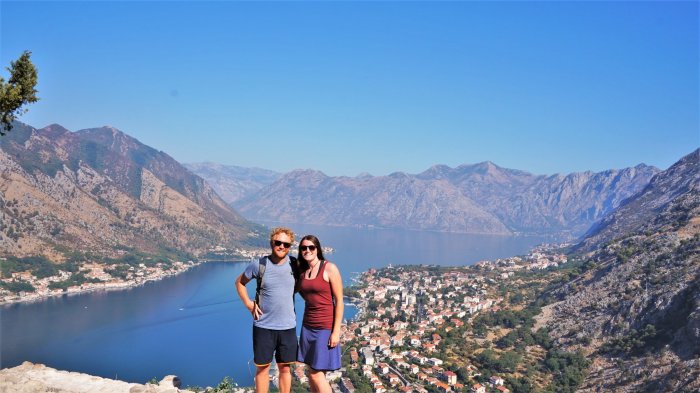
Source: squarespace-cdn.com
In conclusion, crafting a travel around the world itinerary requires meticulous planning, understanding different approaches, and anticipating potential challenges. This guide provides a roadmap to create a seamless global journey. Remember to prioritize your interests, budget, and time constraints while acknowledging the significance of cultural sensitivity. Enjoy your transformative global adventure!
FAQ Corner
What’s the best way to balance must-see attractions with local experiences?
Prioritize attractions that resonate most with your interests. Then, dedicate time to exploring local markets, interacting with locals, and trying regional cuisine. Research local events and festivals for a deeper immersion.
How can I create a realistic timeline for my global itinerary?
Break down your trip into manageable segments (e.g., regions or countries). Research travel times between destinations and factor in buffer time for unexpected delays. Be realistic about daily activity levels and consider travel times for attractions. Don’t overschedule!
What are some tips for finding affordable accommodations and transportation options?
Explore budget-friendly accommodation options like hostels, guesthouses, and Airbnb. Utilize online platforms for comparing transportation options (trains, buses, flights). Be flexible with travel dates to potentially find better deals. Consider traveling during the off-season.
What are the key differences between a fast-paced and a relaxed travel experience?
A fast-paced trip focuses on ticking off many destinations quickly, often sacrificing deeper cultural immersion. A relaxed approach allows more time for in-depth exploration, local experiences, and connecting with the culture and people.


